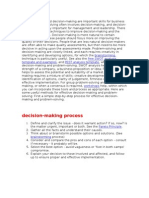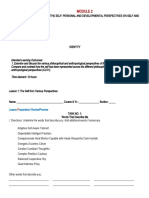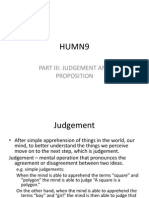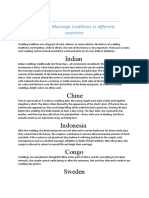09 Handout 1
09 Handout 1
Uploaded by
Arian RoxasCopyright:
Available Formats
09 Handout 1
09 Handout 1
Uploaded by
Arian RoxasOriginal Title
Copyright
Available Formats
Share this document
Did you find this document useful?
Is this content inappropriate?
Copyright:
Available Formats
09 Handout 1
09 Handout 1
Uploaded by
Arian RoxasCopyright:
Available Formats
SH1660
Test of Hypothesis
Statistical Hypothesis – is an assertion or conjecture concerning one or more populations.
Types of Statistical Hypotheses
· Null Hypothesis – denoted by ! , is a statement that shows that there is no significant
difference between population parameter and the value that is being claimed. It is the
hypothesis to be tested.
· Alternative Hypothesis – denoted by " or # , is a statement that shows that there is a
significant difference between the population parameter and the value that is being claimed.
This is a statement that will be true once the null hypothesis is rejected.
Null and Alternative Hypothesis Examples
1. The manager of a TV Station claims that the mean number of people in Manila watching their
new sitcom is 500,000 each day. A student researcher who wants statistical evidence on this
claim conducted her own survey. Her survey resulted to a mean of 499,995. Using a 0.05
significance level, can it be concluded that the mean number of people watching the new sitcom
is less than 500,000? Identify the null and the alternative hypotheses.
2. Last year, the mean number of bags produced by GB Company was 2,500 each day. This year,
the manager claims that there is an increase in the number of bags produced. A researcher who
wants to find out whether this is true counted the number of bags produced each day for a
period of one (1) month. His computation resulted to a mean of 2,515 bags. At 0.05 significance
level, is there enough evidence to conclude that the mean number of bags produced by GB
Company is greater than 2,500? Identify the null and the alternative hypothesis.
3. The Head of the Mathematics Department of a certain high school claims that the mean height
of Grade 7 students is 163 cm. The mean height of 45 randomly selected Grade 7 students is
161 cm. Using 0.01 significance level, can it be concluded that the mean height of Grade 7
students is different from 163 cm as claimed by the Head of the Mathematics Department?
Identify the null and the alternative hypotheses.
Types of Hypothesis Test
· Left-tailed - if # states that the parameter is less than the value claimed in ! .
· Right-tailed - if # states that the parameter is greater than the value claimed in !
· Two-tailed - if # states that the parameter is different from (or not equal to) the value claimed
in ! .
Test Statistic Sample Situation
Shennen owns a cat named Token. She brings Token to a local veterinarian for a regular check-up. Let
$ be a random variable that represents Token’s resting heart rate (in beats per minute). Based on past
records, $ has a normal distribution with % = 12. The vet checked the manual for this kind of cat and
found that for cats of this breed, & = 140 beats per minute. Over the past 5 weeks, Token’s heart rate
(beats/min) measured as follows: 147 126 138 119 108.
The sample mean $ = 127.6. The vet is concerned that Token’s heart rate may be slowing. Does the
data indicate that this is the case?
09 Handout 1 *Property of STI
Page 1 of 8
SH1660
Answer: Since null hypothesis basically means “nothing has changed”, we can assume that
Token’s heart rate should be near average. Hence, ! : & = 140
Since the vet is concerned that Token’s heart rate is slowing, this point of view is represented by
the alternative hypothesis # : & < 140
Getting the probability of obtaining a sample mean of 127.6 or less from a population with true
mean µ = 140. If this probability is small, we can conclude that ! : & = 140 is not valid. Rather,
# : & < 140 and Token’s heart rate is slowing.
()* #./.3)#5!
Test statistic = ' = + = 67 ≈ −2.31
√- √8
Interpretation: If ! : µ = 140 is in fact true, the probability of getting a sample mean of $ ≤ 127.6
is only about 1.044% Because this probability is small, we reject ! : µ = 140 and conclude that
# : µ < 140. Token’s average heart rate seems to be slowing.
The E-value of a Hypothesis Test
The F-value or calculated probability is the estimated probability of rejecting the null hypothesis ( ! )
of a study question when that hypothesis is true. The smaller the F-value computed from sample data,
the stronger the evidence against ! .
E-value and the types of Hypothesis Test
Let G( represent the standardized sample test statistic for testing a mean & using the standard
()H
normal distribution. That is, G( = I .
K J
√
I. Left-tailed Test F-value = F(' < '( )
!: & = L #: & < L This is the probability of getting a test statistic
as low as or lower than '( .
II. Right-tailed Test F-value = F(' > '( )
!: & = L #: & > L This is the probability of getting a test statistic
as high as or higher than '( .
09 Handout 1 *Property of STI
Page 2 of 8
SH1660
Q)RSTUV
III. Two-Tailed Test = F(' > |'( |); therefore,
!: & = L #: & ≠ L
.
F-value = 2F(' > |'( |)
This is the probability of getting a test statistic
either lower than −|'( | or higher than |'( |.
APPLICATION:
The Department of Environment and National Resources (DENR) has been studying Pringle Creek
regarding ammonia nitrogen concentration. The concentration has been 2.2 mg/l for couple of years.
However, the residents of the village where the creek is located are raising concern that the
concentration may have changed. Any change in the ammonia nitrogen concentration can affect the
living things such as plants and animals in and around the creek. Let $ be a random variable
representing ammonia nitrogen concentration. Based on the recent studies of Pringle Creek, $ has a
normal distribution with % = 0.30. A random sample of eight (8) water test from the creek is as follows:
2.1 2.0 2.5 2.2 2.7 2.9 2.1 2.4.
Construct a statistical test to examine the claim that the concentration of ammonia nitrogen has
changed from 2.2 mg/l. Use level of significance W = 0.01
Basic Components of a Statistical Test
a. Null Hypothesis ! , Alternative Hypothesis # , and preset level of significance α
If the evidence against ! is strong enough, we reject ! and adopt # . The level of significance
α is the probability of rejecting ! when it is, in fact, true.
b. Test Statistic and Sampling Distribution
These are the mathematical tools used to measure compatibility of sample data and the null
hypothesis.
c. F-value
This is the probability of obtaining a test statistic from the sampling distribution that is extreme as,
or more extreme than, the sample test statistic computed from the data under the assumption that
! is true.
d. Test Conclusion
If F-value ≤ α, we reject ! and say that the data are significant at level α. If F-value > α, we do
not reject ! .
e. Interpretation of the test results
Give a simple explanation of your conclusions in the context of the application.
Steps in Hypothesis Testing Example 1
Jack ‘n Jill, a company that produces snack foods, uses a machine to package 453-oz bags of potato
chips. Assuming that the net weights are normally distributed with mean 453oz with the standard
09 Handout 1 *Property of STI
Page 3 of 8
SH1660
deviation of all such weights is 7.8oz, they want to test if the machine is working properly. A random
sample of 25 bags is checked. The weights are as follows:
464 457 438 453 448 449 440 450
469 432 454 464 449 446 445 455
446 458 456 434 451 447 448 446
452
Does the sample provide sufficient evidence to conclude that the packaging machine is not working
properly at a 5% level of significance?
Testing mean X when Y is unknown Example
The drug 6-mP is used to treat leukemia. The following data represent the remission times (in weeks)
for a random sample of 20 patients using 6-mP. (Brase, 2012)
9 8 31 23 21 5 17 33
32 26 19 20 7 17 36 7
12 9 6 10
The sample mean is $ ≈ 17.4 weeks with sample standard deviation Z ≈ 10.08. Let $ be a random
variable representing the remission time (in weeks) for all the patients using 6-mP. Assume that $
distribution is mound-shaped and symmetric.
A previously used drug treatment dah a mean remission time of µ = 12.5 weeks. Do the data indicate
that the mean remission time using the drug 6-mP is different (either way) from 12.5 week at a 1%
level of significance?
Process in Getting E-value
Given:
\ = 2.108
] = 21
^. _. = 21 − 1 = 20
Type of test = two-tailed test
Find the F-value.
Solution:
Using the table for \-distribution, we find an interval containing the F-value. Since this is a two-tailed
test, we use entries from the row headed by two-tail area. Look up the \-value in the row headed by
d. _ = 20. The sample statistic \ = 2.108 falls between 2.086 and 2.528. The F-value for the sample
t falls between the corresponding two-tail areas 0.050 and 0.020.
09 Handout 1 *Property of STI
Page 4 of 8
SH1660
See the figure below for easier understanding.
Excerpt from Student’s t Distribution
... ...
one-tail area
0.050 0.020
two-tail area
^. _ = 20
2.086 2.528
Sample t = 2.108
E – Value:
0.020 < E-value < 0.050
Testing X Using Critical Regions
Figure 1. Critical Regions for `a : X = b
(a) # : & < L (b) # : & > L (c) # : & ≠ L
Left-tailed Right-tailed Two-tailed
W
W
Figure 2: Critical Values
Level of c = a. ad c = a. ae
Significance
09 Handout 1 *Property of STI
Page 5 of 8
SH1660
For a left-tailed
test
`e : X < b
Critical Value fa
Critical Region:
All z < fa
For a right-tailed
test
`e : X > b
Critical Value fa
Critical Region:
All z > fa
For a two-tailed
test
`e : X ≠ b
Critical Value fa
Critical Region:
All z < −fa
together with all
z > +fa
Situation:
Let $ be a random variable representing the number of sunspots observed in a four-week period. A
random sample of 40 such periods from Spanish colonial times gave the number of sunspots per period.
The sample mean is $ ≈ 47.0 with % = 35. It is thought that for thousands of years, the mean number
of sunspots per four-week period was about & = 41. Do the data indicate that the mean sunspot activity
during the Spanish colonial period was higher than 41? Use W = 0.05. (Brase, 2012)
Population Proportion Formula
î − i î − i
'= mn ' =
il
k ki(1 − i)
] ]
09 Handout 1 *Property of STI
Page 6 of 8
SH1660
where:
î = sample proportion
i = population proportion
] =sample size
l =1−i
The following are the steps when testing hypothesis concerning a proportion:
Step 1 – State the null and the alternative hypotheses.
Step 2 – Choose a level of significance W.
Step 3 – Compute the test statistic.
Step 4 – Determine the critical value.
Step 5 – Make a decision.
Null Hypothesis:
The null hypothesis is usually written in the form:
! : = i!
where i! = specific numerical value for the population proportion i.
Alternative Hypothesis:
The alternative hypothesis can be any of the following:
" : i ≠ i! (two-tailed test)
" : i > i! (one-tailed test)
" : i < i! (one-tailed test)
Example:
It is believed that in the coming election, 65% of the voters in the province of Pampanga will vote for
the administration candidate for governor. Suppose 713 out of the 1,150 randomly selected voters
indicate that they would vote for the administration candidate. At 0.10 level of significance, find out
whether the percentage of voters for the administration candidate is different from 65%.
Solution:
Step 1: State the null and the alternative hypotheses.
! : i = .65
" : i ≠ .65
Step 2: Choose a level of significance: W = 0.10
Step 3: Compute the test statistic.
$
î =
]
713
=
1,150
= 0.62
î − i
'=
ki(1 − i)
]
09 Handout 1 *Property of STI
Page 7 of 8
SH1660
0.62 − 0.65
'=
0.65(1 − 0.65)
k
1,150
' = −2.133
Step 4: Determine the critical value.
The alternative hypothesis is non-directional. Hence, the two-tailed test shall be used. Divide W by 2,
and then subtract the quotient from 0.5.
W 0.10
= = 0.05
2 2
0.5 − 0.05 = 0.45
Using the Areas Under the Normal Curve Table, 'p = 1.645. At 10% level of significance the critical
7
value is ±1.645.
www.mathandstatistics.com
Step 5: Since the computed test statistic ' = −2.133 falls in the rejection region, reject the null
hypothesis. Conclude that at 0.10 level of significance, there is enough evidence that the percentage of
voters for the administration candidate is different from 65%.
Reference: Brase, C., (2012). Basic Statistics (5th Edition). Ortigas Avenue, Pasig City: Cengage
Learning
09 Handout 1 *Property of STI
Page 8 of 8
You might also like
- 50 Challenging Calculus Problems (Fully Solved) - Chris McMullenDocument236 pages50 Challenging Calculus Problems (Fully Solved) - Chris McMullenLodavin100% (12)
- Reflection Paper in "The Stigma of Mental Illness"Document1 pageReflection Paper in "The Stigma of Mental Illness"ClarsayartNo ratings yet
- Running Head: 1: Reflection PaperDocument4 pagesRunning Head: 1: Reflection PaperArrow PhotoNo ratings yet
- Collaborative Research Proposal For Sugarcane BreedingDocument6 pagesCollaborative Research Proposal For Sugarcane Breedingpteron010% (1)
- 3 - Knowing The TruthDocument34 pages3 - Knowing The TruthJhelynne G.No ratings yet
- EthicsDocument48 pagesEthicsRushi VyasNo ratings yet
- (Jonathon D. Brown) Self-Esteem It's Not What YouDocument36 pages(Jonathon D. Brown) Self-Esteem It's Not What YouRedouane AmezoirouNo ratings yet
- Scale-Chord RelationshipsDocument4 pagesScale-Chord RelationshipsArnold Yohanes100% (1)
- Local Media5165355875185176994Document174 pagesLocal Media5165355875185176994Katrine ManaoNo ratings yet
- Activity 7.1 - Big History 1 ReviewDocument4 pagesActivity 7.1 - Big History 1 ReviewIvanNo ratings yet
- Reflection Paper in Philosophy Allegory and Rene Descartes - MatiasDocument2 pagesReflection Paper in Philosophy Allegory and Rene Descartes - MatiasJerald MatiasNo ratings yet
- Take On Another School Year Why PDFDocument28 pagesTake On Another School Year Why PDFEmmanuel PaladaNo ratings yet
- Levels of MeasurementDocument4 pagesLevels of MeasurementZayed Mohammad JohnyNo ratings yet
- Decision Making ProcessDocument7 pagesDecision Making Processspencer2003No ratings yet
- The Avcado Tree by - Marcelino JRDocument7 pagesThe Avcado Tree by - Marcelino JRPrincess Jhaycel LamerNo ratings yet
- Evaluative (Assertion and Claims)Document3 pagesEvaluative (Assertion and Claims)aldren alferez33% (3)
- Who Is A FilipinoDocument2 pagesWho Is A Filipinowhiteknight457No ratings yet
- Lesson 7A Fundamental Skills & Drills The Serve Set Your GoalsDocument4 pagesLesson 7A Fundamental Skills & Drills The Serve Set Your GoalsKim Tanjuan100% (1)
- Heading: 2. Business Letter Writing A. Parts of The Business LetterDocument12 pagesHeading: 2. Business Letter Writing A. Parts of The Business LetterGileah Ymalay ZuasolaNo ratings yet
- R - v1 - Blackspots Idetification HM Naqvi PDFDocument32 pagesR - v1 - Blackspots Idetification HM Naqvi PDFbalaNo ratings yet
- Views About SelfDocument15 pagesViews About Selfbtsvt1307 phNo ratings yet
- MYBODYDocument10 pagesMYBODYRiss EdullantesNo ratings yet
- 1bsn6 Nopre Ajd PrelimsDocument20 pages1bsn6 Nopre Ajd PrelimsAnne Julian Dasco NopreNo ratings yet
- History EssayDocument2 pagesHistory EssayNora Lyn M. TorresNo ratings yet
- Hand Out 3 - An Anthpological Conceptualization of The SelfDocument2 pagesHand Out 3 - An Anthpological Conceptualization of The SelfLorlie CastroNo ratings yet
- Module 1.1 (Identify The Ethical Aspect of Human Life and The Scope of Ethical Thinking)Document27 pagesModule 1.1 (Identify The Ethical Aspect of Human Life and The Scope of Ethical Thinking)Gabriella Joyce JavaNo ratings yet
- Understanding The SelfDocument24 pagesUnderstanding The Selfelvie dijanNo ratings yet
- CwtsDocument12 pagesCwtsLorde FloresNo ratings yet
- Environmental SanitationDocument25 pagesEnvironmental SanitationAlessandra Marigold Aguilar PerezNo ratings yet
- Che Che A Del RosarioDocument1 pageChe Che A Del RosarioralpNo ratings yet
- SamplingDocument66 pagesSamplingMerleAngeliM.SantosNo ratings yet
- Instructional Module: Republic of The Philippines Nueva Vizcaya State University Bayombong, Nueva VizcayaDocument14 pagesInstructional Module: Republic of The Philippines Nueva Vizcaya State University Bayombong, Nueva VizcayaMary Jane BugarinNo ratings yet
- Acctg 1Document39 pagesAcctg 1Clarize R. MabiogNo ratings yet
- The Impact of New ICTs On Everyday LifeDocument30 pagesThe Impact of New ICTs On Everyday LifehobokartNo ratings yet
- Self Reflection PaperDocument4 pagesSelf Reflection Paperapi-315130268No ratings yet
- Long Test 2nd GradingDocument3 pagesLong Test 2nd GradingRyalyn_AnneNo ratings yet
- Affirmative Action vs. Client Wishes Teaching NotesDocument2 pagesAffirmative Action vs. Client Wishes Teaching NotesPatrick OnumahNo ratings yet
- Module 2 The Self From Philosophical and Anthropological PerspectivesDocument10 pagesModule 2 The Self From Philosophical and Anthropological PerspectivesAjhay BonghanoyNo ratings yet
- BSNS1B - M6 Post Task - CaparasDocument5 pagesBSNS1B - M6 Post Task - CaparasGretta CaparasNo ratings yet
- Notes in LogicDocument6 pagesNotes in LogicMae Ann SolloNo ratings yet
- Asuncion 2221325 Module 1 - Missionary ResponseDocument4 pagesAsuncion 2221325 Module 1 - Missionary ResponseMiguel AsuncionNo ratings yet
- Sample Quanti Teenagers Exposure To Parenting Style and Mental Health Restrivera Et Al. 2019 1Document79 pagesSample Quanti Teenagers Exposure To Parenting Style and Mental Health Restrivera Et Al. 2019 1Kyla IsabelNo ratings yet
- Information Age Assignment SALARDADocument2 pagesInformation Age Assignment SALARDADoneva Lyn MedinaNo ratings yet
- How Would You Characterize Yourself?Document2 pagesHow Would You Characterize Yourself?Joannah Patima PriceNo ratings yet
- Reflection On The Pursuit of Happyness MovieDocument5 pagesReflection On The Pursuit of Happyness MovieRammel Buena100% (1)
- NAME: ASUNCION, Seigfreid Miguel M. Course and Year: Bs Mls 1Document2 pagesNAME: ASUNCION, Seigfreid Miguel M. Course and Year: Bs Mls 1Miguel AsuncionNo ratings yet
- My Quarantine ExperienceDocument3 pagesMy Quarantine ExperienceAnquillano RhoseNo ratings yet
- Judgements and Propositions (Handout)Document29 pagesJudgements and Propositions (Handout)John Mark Bermal EspalmadoNo ratings yet
- Cruz - Bscpe - 1-1 - Task#4 The First Law of ThermodynamicsDocument2 pagesCruz - Bscpe - 1-1 - Task#4 The First Law of ThermodynamicsJoshua CruzNo ratings yet
- Practice Set - Analysis of FS1Document1 pagePractice Set - Analysis of FS1marissa casareno almueteNo ratings yet
- Instructions: NSTP Module 1Document8 pagesInstructions: NSTP Module 1renNo ratings yet
- Bible Study Script - Service For The DepartedDocument3 pagesBible Study Script - Service For The DepartedLiswani NyauNo ratings yet
- Categorical PropositionDocument19 pagesCategorical PropositionBary PatwalNo ratings yet
- Our Environment and The Relationship Between Mankind and NatureDocument5 pagesOur Environment and The Relationship Between Mankind and NatureHans Neukomm100% (2)
- Normative EthicsDocument25 pagesNormative EthicsSharina GonzalesNo ratings yet
- LESSON7Document8 pagesLESSON7Rhey Nocus100% (1)
- Readings in Philippine HistoryDocument16 pagesReadings in Philippine HistoryMuhammad Shaquille Casuyon Maquiran100% (1)
- Lesson 1: Philosophy: Socrates and PlatoDocument7 pagesLesson 1: Philosophy: Socrates and PlatoNerish PlazaNo ratings yet
- Fireproof Reflection PaperDocument1 pageFireproof Reflection PaperFebb AeronNo ratings yet
- Logic SyllogismDocument14 pagesLogic SyllogismJames NitsugaNo ratings yet
- Abm 1... ProportionDocument12 pagesAbm 1... ProportionJoanes OcamiaNo ratings yet
- Checked PRACTICAL RESEARCH CHAPTER 1 (GROUP 2)Document13 pagesChecked PRACTICAL RESEARCH CHAPTER 1 (GROUP 2)margarita perez100% (1)
- The Case for Masks: Science-Based Advice for Living During the Coronavirus PandemicFrom EverandThe Case for Masks: Science-Based Advice for Living During the Coronavirus PandemicNo ratings yet
- Evidentiary ObjectionsDocument11 pagesEvidentiary ObjectionsAndJustice4SomeNo ratings yet
- Sunrise - 10 TB PDFDocument153 pagesSunrise - 10 TB PDFDroid Kurd79% (19)
- Lesson 6 Example ProblemsDocument9 pagesLesson 6 Example ProblemsOksana MandrykNo ratings yet
- Urgent Field Safety NoticeDocument5 pagesUrgent Field Safety NoticeHama364No ratings yet
- GZB LeadsDocument113 pagesGZB Leadsvarun vikramNo ratings yet
- Indian: Marriage Traditions in Different CountriesDocument3 pagesIndian: Marriage Traditions in Different CountriesZümrüd BabazadeNo ratings yet
- Long and Short VowelsDocument17 pagesLong and Short VowelsAna Virginia Fernández100% (1)
- Fruitful Trees The Spirit's SowingDocument1 pageFruitful Trees The Spirit's SowingDominique Lim YañezNo ratings yet
- Ethics Learning PlanDocument6 pagesEthics Learning PlanGLAIZA ABUCAYNo ratings yet
- Proficiency Level, Race, Ethnicity and High School Destinations of The 2012-13 7th Grade Cohort of NYC Middle SchoolsDocument1 pageProficiency Level, Race, Ethnicity and High School Destinations of The 2012-13 7th Grade Cohort of NYC Middle SchoolsDNAinfoNewYork100% (1)
- Parts of The Digestive System Matching Worksheet PDFDocument2 pagesParts of The Digestive System Matching Worksheet PDFMon Duray BalaniNo ratings yet
- Ecarcelen Resume WebsiteDocument2 pagesEcarcelen Resume Websiteapi-512220241No ratings yet
- GALLAGHER, J. ROBINSON, R. The Imperialism of Free TradeDocument16 pagesGALLAGHER, J. ROBINSON, R. The Imperialism of Free TradePê AgáNo ratings yet
- Alexander Hamilton INFOGRAPHICDocument1 pageAlexander Hamilton INFOGRAPHICmolly zhangNo ratings yet
- Jti - Rfic NotesDocument2 pagesJti - Rfic NotesmuralikrishnavNo ratings yet
- Protection of Rights of The Scheduled Tribes in India With Special Reference To Chenchu Tribes in Kurnool District of Andhra PradeshDocument11 pagesProtection of Rights of The Scheduled Tribes in India With Special Reference To Chenchu Tribes in Kurnool District of Andhra PradeshramanjaneyuluNo ratings yet
- John KeatsDocument2 pagesJohn KeatsAina KhanNo ratings yet
- The Passive: Context Listemn EiDocument6 pagesThe Passive: Context Listemn EiDavid OrtegaNo ratings yet
- On Tamil MilitarismDocument76 pagesOn Tamil MilitarismSharmalan ThevarNo ratings yet
- Paper VIII 20th Century British LiteratureDocument107 pagesPaper VIII 20th Century British LiteratureКатерина ШевченкоNo ratings yet
- Hardam Furigay Colleges Foundation, IncDocument2 pagesHardam Furigay Colleges Foundation, IncZerhan LaarinNo ratings yet
- Grade 4 Math - Estimating Differences Rounding DecDocument3 pagesGrade 4 Math - Estimating Differences Rounding Decapi-557721233No ratings yet
- An Analysis of The Kelsons Theory of LawDocument14 pagesAn Analysis of The Kelsons Theory of LawAnonymous mpgedaEftNo ratings yet
- Uber-Waymo Page Deposition Ruling 7:10:17Document3 pagesUber-Waymo Page Deposition Ruling 7:10:17CNET NewsNo ratings yet
- Ilptlp 1Document4 pagesIlptlp 1api-483676186No ratings yet
- Macalintal vs. ComelecDocument1 pageMacalintal vs. ComelecRJ TurnoNo ratings yet
- Carbon Nanotube Field Effect Transistor Aptasensors For Estrogen Detection in LiquidsDocument9 pagesCarbon Nanotube Field Effect Transistor Aptasensors For Estrogen Detection in LiquidsNilashis RoyNo ratings yet

























































































